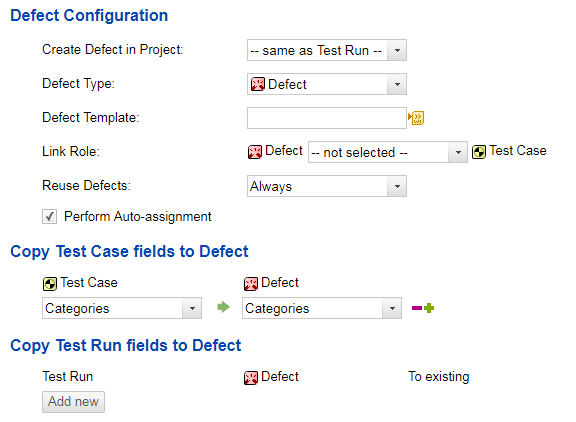Defect configuration
Administrators can configure how and when defects are automatically created when a Test Case fails in a Test Run.
( Administration
Administration
 Testing
Testing
 Configuration)
Configuration)

Create Defect in Project
Defines the project in which Defects (resulting from failed tests) should be created.
Defect Type
Defines which of the configured Work Item types is used to represent Defects resulting from test failures.
(Work Item Types are configured in  Administration
Administration
 Work Items
Work Items
 Enumerations.)
Enumerations.)
Defect Template
Defines which Work Item is used as a template for creating a new Defect type Work Item as a result of test failure while importing results of automated tests, or when a manual Test Case is performed. It is also used as the template for the Summary Defect). Enter the ID of a Work Item from the current project or the project ID and Work Item ID for Work Items from a different project, in this format: projectID/workItemID.
Link Role
Defines which Link Role is used for linking Defect Work Items (created when test results contain failed tests) to Test Case Work Items.
(Link Roles are configured in  Administration
Administration
 Work Items
Work Items
 Enumerations.)
Enumerations.)
Reuse Defects
Defines when the defect created when a test case fails is reused.
Reuse Defect Options:
Never:
When set to Never, if the current Test Record does not have a linked defect, a new defect is always created. While retesting, the defect that is already linked to the test record can be reused.
If failed in group / If failed in previous:
First If failed in group and If failed in previous check iterations of the Test Case in the current Test Run. If there is a resolvable, unresolved, not summary defect, it is reused.
Then they check Test Runs with the same Group as the current Test Run and in the same Project as the current Test Run. If there is a resolvable, unresolved, not summary defect, then it is reused.
Then, the if failed in previous strategy checks Test Runs in the previous group and in the same project as the current test run. (The previous group is determined by searching last Test Run by creation time with a different group.) If there is a resolvable, unresolved, not summary defect, then it is reused.
Otherwise no defect is reused.
Always:
Always finds the top 20 Test Records in the Project of the current Test Run, for the same Test Case that have a defect set.
(Sorted by execution time in descending order.)
It then iterates over these defects and finds the first one that is resolvable and not a summary defect of its Test Run.
If such a defect is found and has no resolution, it is reused.
Otherwise no defect is reused.
Perform Auto-assignment
Defines if auto-assignment should automatically fill the Assignee field in new Defect items created automatically for a failed Test Case.
( Administration
Administration
 Work Items
Work Items
 Auto-assignment.)
Auto-assignment.)
Allow Retest of Manual Test Case
Defines whether rerunning of manually-performed Test Cases is allowed.
Copy Test Case fields to Defect
Defines which fields are copied from the Test Case Work Item to automatically created Defect Work Item(s).
The values from the Test Run, Test Case, and Test Case Verdict fields are hardcoded so that they automatically appear in the Description field of all Defects generated by failed Test Cases.

Copy Test Run fields to Defect
Defines which fields are copied from Test Run to an automatically created Defect Work Item. When the source field is single-enum type field and the target is multi-enum type field, then the value is added, otherwise the value in the target field is overwritten.
When To Existing is selected, then this mapping is also used when an existing defect item is linked to new failed Test Record.